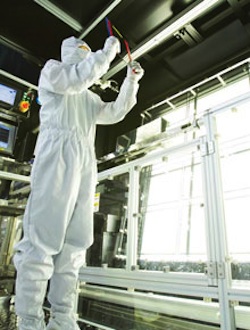KOREA: Samsung and LG dominating world LCD TV panel market
Second-quarter figures also show Samsung's strength in the semiconductor business, where it holds over 40% market share, and that the Korean companies are closing in on mobile phone leader Nokia


Korea's 'big two' consumer electronics manufacturers continue to dominate the world market for TV-size LCD panels, between them accounting for 54% of global supply.
That's the story from sales figures just released for the period from April to June, which saw Samsung shifting LCD panels worth $5.37bn (£3.3bn) to take a market-leading 27.6% share. In second place was LG Display, with sales of $5.07bn (£3.1bn) and a 26.4% share.
Both companies increased their market share since the first quarter of the year, Samsung up by just under one percentage point, and LG 1.7%.
The results are bad news for the troubled Japanese LCD TV businesses: third and fourth in the global rankings were Taiwan's Chimei Innolux ($3.07bn/£1.88bn, 15.9%) and AU Optronics ($3.05bn/£1.87bn, 15.8%), with Sharp the highest-placed Japanese company.
It comes in fifth, with sales of $1.13bn (£693m) and a 5.9% market share.
Overall, it means Korea now accounts for 54% of the global LCD TV panel market, Taiwan 33.7% and Japan just 8.4%. China currently has a 3.6% share, and other countries the remaining 0.4%.
Most of that Japanese share is down to Sharp, which has recently been considering a move to scale down its LCD TV panel manufacturing in favour of smaller displays suited to tablets and other portable devices, as well as alliances with overseas manufacturers for panel supply.
The latest hi-fi, home cinema and tech news, reviews, buying advice and deals, direct to your inbox.
Tough times in LCDs
However, even for some of the bigger players in the LCD market, global economic conditions, plummeting display prices and oversupply is making this a precarious business at the moment.
Both Chimei Innolux and AU Optronics reported losses of more than TWD 10bn (£212m) in the second quarter of the year, blaming oversupply of panels and slumping demand. For Chimei Innolux that makes three loss-making quarters in a row, for AU Optronics four.
AU's executive VP, Peng Shaunglang, says that 'Inventories of LCD TVs and notebook PCs have been piling up quickly in China and Western nations' – notebooks have been hit by the boom in tablet computers, while even in China, eyed by many companies as a source of new revenue in the TV business, growth is only expected to be 10-15% a year, rather than the 30-40% experienced last year.
Both companies plan to reduce capital investment and also cut back production to some 80% of their total capacity.
Top in chips
Meanwhile the strength of Korea in consumer electronics is reinforced by the performance of its companies in the highly competitive semiconductor market: Samsung's chip division had $3.37bn (£2.25bn) of sales in the second quarter of this year, giving it a 41.4% share of the global market.
In total, Korean companies took 65.7% of the global market, trailed by Japan (!4.7%), the US (11.1%) and Taiwan (8.4%).
Meanwhile, in mobile phones...
Finally. more good news for Korean companies from the mobile phone industry, where Samsung and LG seem to be closing in on troubled market leader Nokia. In the second quarter, Samsung sold 69.8m handsets and LG 24.4m, giving them market shares of 16.3% and 5.7% respectively.
That puts them in second and third places behind Nokia, which sold 97.9m phones to register a 22.8% share.
Completing the global mobile phone 'top five' were Apple, selling 19.6m iPhones to take a 4.6% share, and Chinese manufacturer ZTE, with sales of 10.4m units and a 3% share.
Follow whathifi.com on Twitter
Andrew has written about audio and video products for the past 20+ years, and been a consumer journalist for more than 30 years, starting his career on camera magazines. Andrew has contributed to titles including What Hi-Fi?, Gramophone, Jazzwise and Hi-Fi Critic, Hi-Fi News & Record Review and Hi-Fi Choice. I’ve also written for a number of non-specialist and overseas magazines.
